Step-by-Step Diabetic Foot Care Programme
Introduction
When the Rotary Club of Dominica introduced the step-by-step (SbS) diabetic foot care training in Dominica, it was not then evident that this initiative would require intense hard work to achieve the desired goal of reduced lower limb amputation. Success required strong collaborative action among several players, securing (demonstrated) political will, spreading influence across various sector of society and empowering key publics to take action collectively and individually with one goal in mind, reversing the upward trend of lower limb amputations due to diabetes mellitus. Diabetic foot amputations peaked in 2011 the year that SbS training was introduced. One year later the main hospital reported a decline of 25% with a further decline of 72% in 2013. What accounted for this decline is debatable and will have to be evaluated subsequently, when the trend is observed over a longer period of time.
Background
Diabetes Mellitus (DM) is a major public health challenge and a leading cause of death in Dominica. This disease places a significant burden on the health and well-being of the population and the national purse. Analysis of mortality in Dominica (as presented by certificates of death) for 2013, ranked diabetes as the number two cause of death in the total population.
The number of lower limb amputations due to (DM) increased by 100% within a five-year period (2005 to 2010). This alarming data forced the Ministry of Health and civil society organizations to pay attention to this disabling complication of diabetes; One of these organizations was the Rotary Club of Dominica. Significantly, there is no resident podiatrist on island and attention to foot care was not well coordinated as clinics were sporadic and in many instances non-existent.
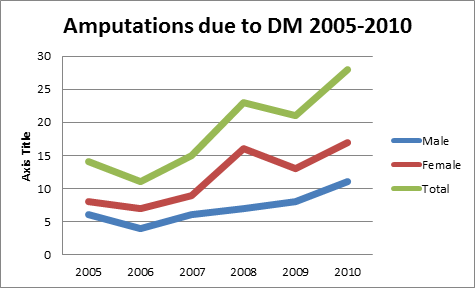
A number of interventions were introduced to address the growing lower limb amputation problem these included:
Training and skills enhancement in diabetic foot management and prevention were organized for health professionals, non-health personnel including pedicurists, attendants at senior citizens homes. People living with diabetes and their caregivers were also exposed to foot care education and practical demonstration on home care. Consequently, special foot care clinics were being held monthly throughout the seven Primary Care health districts.
The actions taken were further strengthened by the introduction of Integrated Care programme for the management of Non Communicable Diseases (NCD) resulting in feet examinations becoming an integral component of diabetes management. Thus the skills acquired through the Step-by-Step programme were timely and greatly facilitate the Ministry’s approach to the management of NCD and specifically diabetic foot care.
The trained health care personnel were each given a set of foot assessment instruments making it easier for them to practice the newly acquired skills. Continuous patient and public education became more intense as awareness of diabetes and complications became a key factor in promoting the required behaviour change.
Training & Skills Enhancement
Training became an important tool and a first step in dealing with this health challenge and was undertaken at several levels.
In early 2011 the Ministry of Health introduced basic foot care training for health care and non health care personnel. In October 2011 the IDF Step-by-Step programme was introduced on island. Participants were taught the principles of basic foot care education and practical management guidelines; given practical training in foot care and equipped with a simple set of instruments for daily practice.
The main aim of training programme was to build low cost health care capacity, reduce lower limb complications and unnecessary amputations and empower people living with diabetes to better take care of their feet.
This training programme was expected to strengthen the foot care programme of the Ministry of Health by training a core of doctors and nurses from Primary Health Care, the Princess Margaret Hospital. This core group, in turn would facilitate skills transfer by training their colleagues and so contribute to the sustainability of the programme.
This programme was made possible with resources from the International Diabetes Federation, Rotary International, and their respective affiliate local organizations and in partnership with the Rotary Clubs of Hereford (United Kingdom), and the Government of Dominica.
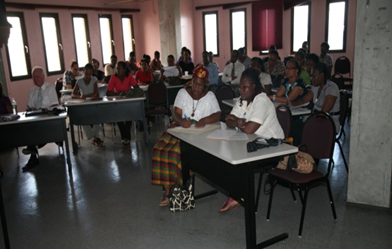 Course 1 of the Step-by-Step Foot Care training programme was completed in Dominica in October 2011. The Twenty-seven nurses and medical practitioners who attended the course were drawn from Primary Health Care Services representing all seven health districts and staff of the Princess Margaret Hospital. The faculty was composed of international, regional and local facilitators, drawn from both the public and private health sectors.
Course 1 of the Step-by-Step Foot Care training programme was completed in Dominica in October 2011. The Twenty-seven nurses and medical practitioners who attended the course were drawn from Primary Health Care Services representing all seven health districts and staff of the Princess Margaret Hospital. The faculty was composed of international, regional and local facilitators, drawn from both the public and private health sectors.
The success of Course 1 was summarized by the lead course facilitator Dr. Vilma Urbančič-Rovan as follows.
The basic Step by Step course in Dominica was a great success, throughout the course there was a lot of interaction and the attendance was high. The willingness and enthusiasm of the course participants and in particular of the local authorities were incredible and the IF (International Faculty) members feel that this makes a good start for the course implementation in the future, and there should be no concern about the course sustainability
An important outcome of this first course was the changes made to the procedure of information logging in the operating room at the hospital. This change made it easier to retrieve data on lower limb amputations due to DM.
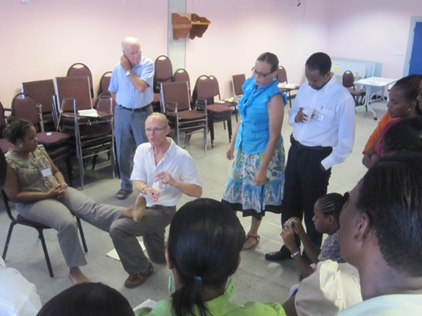
Participants of SbS course 2
26 nurses and medical officers completed both course 1 and course 2 of the Step-by-step training programme.
In his address to mark the closing of SbS training the Honourable Minister for Health expressed a desire to see a significant reduction in the number of diabetic related amputations.
“Within two more years, I would like the incidence of diabetic amputations in Dominica to be reduced by ninety-five percent. Within this year I have been given the assurance that we can reduce it by fifty percent and within the next year we can achieve our target. I am telling you health care providers you have a challenge on your hands” the minister remarked. (Government Information Services, GIS release)
At the same closing ceremony, Dr Vilma Urbančič-Rovan, lead consultant on the SbS Dominica programme commended the health officials for acting on the recommendations, which were made the year before. Dr Urbančič-Rovan was very impressed with the advancement of foot care in Dominica and commented
It’s something unbelievable, in no island so far have we seen the result of our work implemented so quickly, so efficiently and in no island have we seen such enthusiasm from health care authorities and we were in particular pleased by what we have been given from the minister Honourable Julius Timothy because I believe it’s his dedication”. (Dominica Vibes News)
Post SbS – Local Partners take the Lead
The commencement of the foot care clinics and collection of associated data did not live up to expectations following course 1. There was some delay with the data collection forms, while some adjustments were being made to the satisfaction of the Health Information Unit (HIU). However, it was surmised that the health teams may have been hesitant in establishing foot care clinics due to absence of expert guidance. Dominica it must be noted does not have the services of a resident podiatrist.
The Rotary Club of Dominica therefore sought the assistance of one of the faculty members Neil Baker in the recruitment of a podiatrist to help strengthen the skills already acquired by the health professionals as well as help “jump-start” the foot care programme. Podiatrist Anna Evans volunteered her services to Dominica, and international travel and accommodation were provided through financial support from Sagicor Insurance Company and the Ministry of Health. Ms. Evans arrived on Dominica on February 15, 2012 and she departed on April 20, 2012.
Ms. Evans began her assignment in earnest within the Roseau health district on February 23, 2012 and progressed throughout the seven health districts. She spent a week in each Health District, providing on-the-job reinforcement and helping establish special foot assessment clinics. This action also resulted in an additional forty nurses (40) receiving practical training in foot assessment techniques.
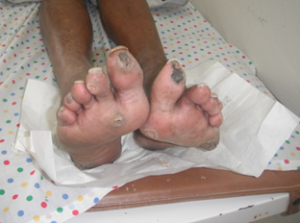
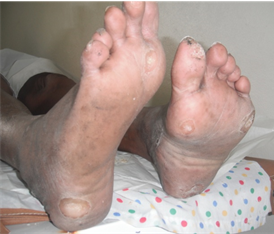
Callus removal demonstrated during on-the-job training at a rural Health Centre
Training for Non-Health Care Personnel
Twenty (20) non-health personnel represented by pedicurists, Senor Citizen Home attendants, patients and their caregivers received formal training under the training programme of the Ministry of Health.
The Dominica Diabetes Association (DOMDA) provides another avenue for people empowerment through continuous education and development of self-management skills. Practical skills such as foot washing and care maintenance are taught in an informal setting utilizing materials and supplies that are in everyday use at the home or easily acquired in the stores.
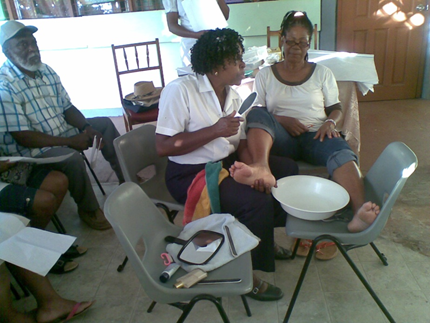
Family Nurse Practitioner and Vice President of DOMDA, gives a practical demonstration of how to care for the feet at home using simple, easily available supplies.
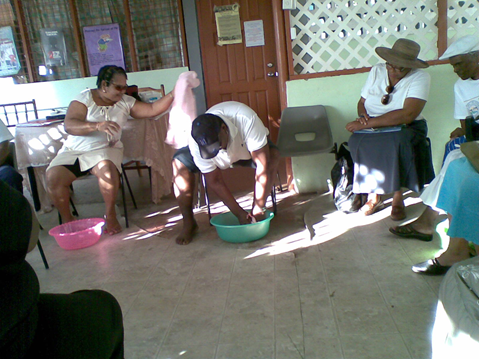
People Living with Diabetes participating in foot washing demonstrations organized by DOMDA
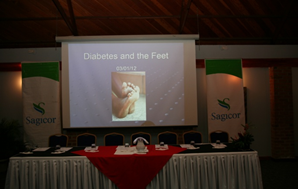
Continuous diabetes education is given at clinics and other non-clinic settings throughout the island.
Additional Assessment equipment were supplied by RC Dominica in efforts to encourage sustained action by the health care providers.
Results
In March 2013 the Permanent secretary in the Ministry of Health, Mrs. Helen Royer revealed that there was a decline in the number of diabetes related amputations ifor the year 2012. Mrs Royer made that announcement at a non-communicable diseases policy development workshop saying:
Part of the reason for this success is the Ministry’s collaboration with the Dominica Rotary Club and the Dominica Diabetes Association, to host a diabetic foot training program in 2011 which focused on reducing the number of amputations due to diabetes. Healthcare workers, non-health workers, diabetics and pedicurist were trained on the management and prevention of diabetic foot. I am pleased to report that that the number of amputees has declined from 35 to 27 that is from 2011 to 2012,
In fact the results seem startling as the hospital recorded a 25% decline in amputations due to DM in 2012 and 72% decline in 2013 (using 2011 as the base year). Results also indicate the lowest total number of amputations in eight years.
The success of this programme depended on creating buy-in from influential and key-stake holders at the local level. Thus right from the start the programme proposal was presented to the Core Managers of the Ministry of Health. An Important factor here is that the “core” group is headed by the Minister for Health. The local organizing committee that eventually emerged consisted of the top Medical Directors at both Hospital and Primary Health care and that gave the necessary importance and prestige to the programme.
Conclusion
The results achieved represent concerted effort on the part of key stakeholders in the Government service, and the NGO sector. These results, though promising, need to be treated cautiously as the reduction in amputations could be the result of the interplay of other factors. Therefore the trend must be observed over a longer period in order to arrive at conclusive evidence of the factors responsible for the results observed. Sustained decreasing trend in lower limb amputation also requires firm integration of diabetic foot care in the overall management of diabetes.


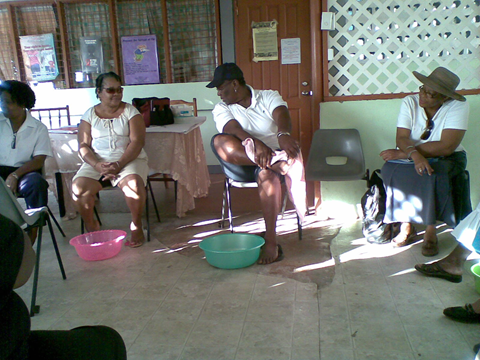
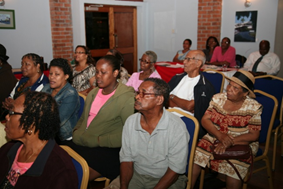

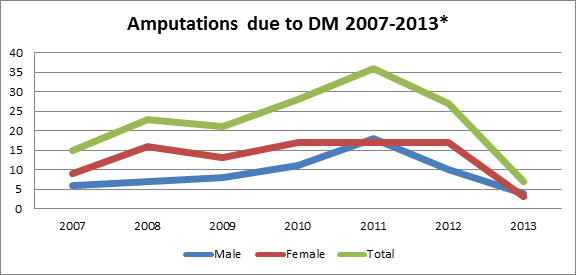
March 11, 2021 @ 12:31 pm
Congratulations on your success to date with this program. I am a member of the Rotary Club of Ajijic, Mexico and in the formative stages of organizing a team comprised of members from a number of Rotary Clubs in the Guadalajara-Chapala area with the objective of screening and educating members of the local communities and villages in the care of their feet to reduce the incidence of foot ulcers and amputations. We will be employing advanced but simple screening tools and educational materials from Arche Healthcare http://www.archehealthcare.com. Our population and available facilities are significantly different than yours in that we will be working through community centers in indigenous villages rather than through a hospital(s) with trained medical staff. Arche has a training program that is very adequate for non-medical volunteers. I look forward to any advice you can provide that you feel would be helpful for our team.
As a side note, Arche, in conjunction with Dr. Scholls School of Podiatry at Rosalind Franklin University in Chicago started working with the Island of St. Lucia and things stalled. The dynamics of that initiative would be very similar to yours, so I am very interested in your program.
February 9, 2022 @ 6:06 am
I and members of the Hereford Rotary Clubs in the UK would be very interested to know what the trends have shown over these past few years. How has the progress been affected by Hurricane Katrina in 2017?
Wishing all our Rotary friends in Dominica well.